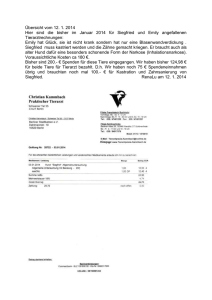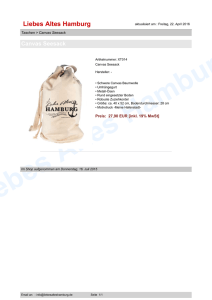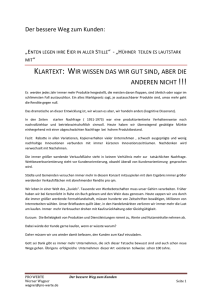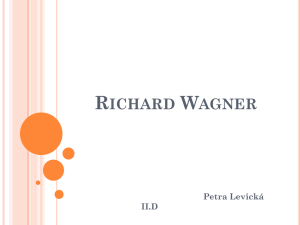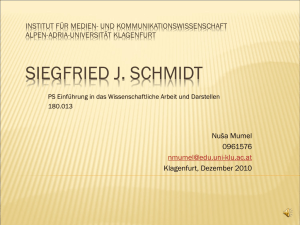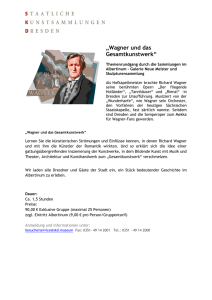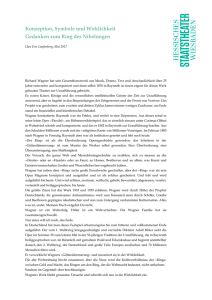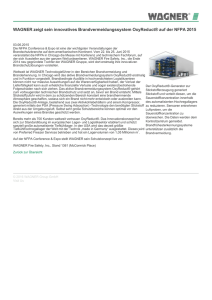Brigid Ibell Katalog 2012 PDF Herunterladen
Werbung
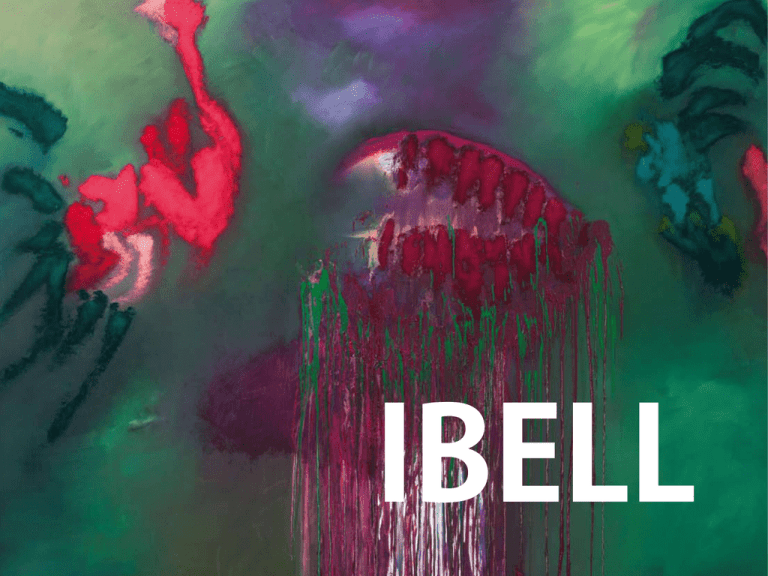
IBELL Eine Partitur aus Farben – eine Werkschau von Brigid Ibell Jasmin Wolfram Schon seit der Romantik beschäftigen sich Philosophen, Kom- rerseits ist es der starke Ausdruck seiner Musik. Diese musi- ponisten und Maler mit der Idee eines Gesamtkunstwerkes. kalische Komposition wird von Brigid Ibell mit der Kraft der Das Ziel ist, das vom Künstler geschaffene Bild mit der Hervor- bildenden Kunst verbunden. Die abstrakte Malerei ermöglicht bringung der Natur gleichzusetzen. ab dem frühen 20. Jahrhundert, den gehörten Ton in Farbe umzusetzen. Durch diese Stilistik ist es der Künstlerin gestat- 1849 befasst sich Richard Wagner in seiner Schrift „Die Kunst tet, die Feinheiten der musikalischen Vorgaben von Wagner und die Revolution“ mit diesem Thema, das ihn ein Leben lang auf Leinwand zu bannen. begleiten wird. Denn es ist die Kunstform der Oper, die eine Verbindung von darstellender und bildender Kunst ermöglicht. Dieser Katalog befasst sich mit der heutigen Wahrnehmung der Verbindung zwischen Musik und Malerei. Die jahrelange So wie Richard Wagner beschäftigt sich auch Wassily Kandinsky und sehr intensive Beschäftigung mit der Musik von Richard mit dieser Komplexität und erkennt 1896 durch die Betrach- Wagner hat Brigid Ibell u.a. zur Realisierung der Bildserie tung eines Gemäldes von Claude Monet „Heuhaufen“ 1890 die „Siegfried Idyll“, nach einem symphonischen Geburtstags- verborgene Kraft der Farben. Zur selben Zeit entdeckt er mit gruß von Richard Wagner an seine Frau Cosima, inspiriert. der romantischen Oper „Lohengrin“, dass die Malerei ebensol- Durch die Verwendung von leuchtenden Orangetönen, verrät che Ausdrucksstärke wie die Musik besitzt. uns die Künstlerin die genaue Uhrzeit der Uraufführung. Es war frühmorgens am Sonntag, den 25. Dezember 1871. Und Richard Wagners Opernkompositionen regen die Künstler im- wenn Sie genau hinsehen, dann entdecken Sie auch den un- mer wieder zur bildnerischen Umsetzung an. Einerseits sind gewöhnlichen Aufführungsort: das Treppenhaus in Wagners es die genauen Bildvorgaben des Komponisten selbst, ande- Tribschener Villa bei Luzern. 3 Ein weiterer Schwerpunkt in der Auseinandersetzung mit der tende Dunkelheit lässt uns Ungemach erahnen. Ob dies die Musik von Richard Wagner wird durch die neuen Arbeiten zu Tötungsabsicht Siegfrieds durch Mime oder die sukzessiven „Siegfried“, zweiter Tag des „Ring des Nibelungen“, veran- Zerstörung der Natur symbolisiert, liegt im Ermessen der per- schaulicht. sönlichen Interpretation. Brigid Ibell holt die Thematik der Nibelungensage aus der ro- Ein immer wieder kehrendes Sujet dieser Werkserie ist die mantischen Sichtweise heraus und taucht sie in die Farben Darstellung des im zweiten Aufzug in Erscheinung tretenden des 21. Jahrtausends. Inspiriert von den gesellschaftlichen Waldvogels. Durch das Blut Fafners auf Siegfrieds Zunge, ist und politischen Veränderungen der letzten Jahre, werden die dieser in der Lage die Sprache der Tiere zu verstehen. Der in Akteure von einst zu handelnden Personen der Gegenwart. rote Farbe getauchte Waldvogel ist Sinnbild für die Erkennt- Tauchen Sie ein in ein Reich geprägt von Habgier, Furchtlosig- nis. Das Blut Fafners in heutiger Zeit manifestiert sich in den keit oder der zu verteidigenden ethischen Normen. Es ist eine immer wieder auftretenden Naturkatastrophen. Erst durch sehenswerte Bilderreise aus Öl und Pigment auf Leinwand. diese schärft sich der Blick für das Wesentliche und für die großen Zusammenhänge der globalen Gesamtheit. Beim Betrachten des Bildes „Siegfried im Wald“ überlässt die Künstlerin dem Betrachter die Wahl, ob er sich durch die Die einst von Richard Wagner vertonte Nibelungensage ist Intensität der grünen Farbgebung inmitten eines Waldes, durch die Verbildlichung von Brigid Ibell ein Spiegelbild der jenem Ort, wo Siegfried vom Schmied Mime großgezogen gegenwärtigen gesellschaftspolitischen Situation geworden wurde, befindet oder ob er das Grün als die zu schützende - schauen Sie nicht weg, sondern werfen Sie einen aufmerk- Mutter Natur interpretieren möchte. Die langsam Einzug hal- samen Blick darauf! 4 A score in colour – works by Brigid Ibell Jasmin Wolfram Since the Romantic era, philosophers, composers and paint- late music into visual art. This occurs on the one hand through ers have struggled to create a “Gesamtkunstwerk” a complete the precise creative intention of the composer and on the work of art. Their quest has been to set art on a similar level other through his exceptional musical expression. Brigid Ibell to nature. merges the musical composition with the medium of fine art. In his Art and Revolution “Die Kunst und die Revolution”, From the start of the 20th century, abstract painting has en- (1849) the composer Richard Wagner examines this theme abled “heard tone” to be expressed as colour. It is through this which was to preoccupy him throughout his life. And it is the medium that the artist Brigid Ibell transfers the tonal nuances art form of opera which makes the connection between the of Wagner on to canvas. performing and visual arts most possible. This catalogue examines the contemporary perception of the Like Wagner, Wassily Kandinsky also struggled with this com- connection between music and painting. After many years of plex relationship. Viewing the painting “Haystacks” by Claude intense study of the music of Richard Wagner, Brigid Ibell has Monet (1890), he discovered the concealed strength of colour. also produced a series of atmospheric paintings on the sym- By comparing that with Wagner‘s romantic opera “Lohengrin”, phony “Siegfried Idyll”, written by Wagner for his wife Cosima Kandinsky realized that painting possesses as much expres- to honour her 33rd birthday. sive power as music. Through the use of luminous orange tones the artist suggests It is the operatic compositions of Richard Wagner, more than the time when the music was played... namely very early on any others, which have inspired artists in attempting to trans- Christmas Day 1871. And if you look very carefully, you might 6 even detect the unusual place, namely the atmospheric stair- interpret the leafy green trees more comfortingly, as protec- case in Wagner‘s Tribschener Villa on Lake Lucerne. tive Mother Nature. The creeping darkness, however, evokes uneasy thoughts. Another emphasis in her evocation of Richard Wagner‘s music is apparent in the new series of paintings entitled “Siegfried”, Whether these signify Siegfried‘s plan to kill the disguised the second day of the Ring der Nibelungen. Brigid Ibell takes beast or symbolise the destruction of nature depends on per- the mythical theme of the “Nibelungen” out of romanticism sonal interpretation. and steeps it in the colours of the 21st century. A recurring subject in this second opera is the little forest bird Inspired by societal and political changes of the past few which Siegfried is able to “understand” after licking Fafner‘s years, she makes Wagner‘s characters part of the present. She blood. (Doing so enables him to understand all animals). The submerges one in a wealth of avarice, fearlessness and even little wild bird, drenched in red, is the symbol of revelation or defence of ethnic norms. It is a worthwhile trip into a world of discovery. Fafner‘s blood manifests itself in the present day as oil and brilliant pigment on canvas. do ever greater and more frequent natural catastrophes. Viewing the painting “Siegfried im Wald (Siegfried in the for- These disasters have sharpened our awareness of the insepa- est)” one becomes aware that the artist has left the viewer a rable inter-connectivity of our global environment. In Brigid choice. One may either get lost in the intense foliage of the Ibell‘s depiction, the Nibelungensage is no longer just mythol- depths of the forest (the same forest where Siegfried was ogy. It becomes also a mirror of our contemporary social and brought up by the dwarf Mime). Or the viewer may instead political world. Don‘t look away, rather look in. 7 Letzte Haltung Fafners, 2011, Öl und Pigment auf Leinwand, 190 cm x 240 cm Fafner‘s last Stance, 2011, oil and pigment on canvas, 190 cm x 240 cm 8 9 Die Raubvögel, 2008, Öl und Pigment auf Leinwand, 140 cm x 160 cm Birds of prey, 2008, oil and pigment on canvas, 140 cm x 160 cm 10 11 Stimme des Waldvogels, 2011, Öl und Pigment auf Leinwand, 190 cm x 240 cm Forest bird song, 2011, oil and pigment on canvas, 190 cm x 240 cm 12 13 Nachrichten für Mathilde, 2011, Acryl/Mischtechnik auf Holz, 20 cm x 50 cm Messages for Mathilde, 2011, acrylic/mixed media on wood, 20 cm x 50 cm 14 15 Im Wald, 2010, Öl und Pigment auf Leinwand, 100 cm x 100 cm In the forest, 2010, oil and pigment on canvas, 100 cm x 100 cm 16 17 Wasserspiegel, 2010, Öl und Pigment auf Leinwand, 140 cm x 160 cm Water mirror, 2010, oil and pigment on canvas, 140 cm x 160 cm 18 19 Waldflora, 2010, Öl und Pigment auf Leinwand, 190 cm x 240 cm Forest flora, 2010, oil and pigment on canvas, 190 cm x 240 cm 20 21 Waldgestalten, 2008, Öl und Pigment auf Leinwand, 140 cm x 160 cm Forest figures, 2008, oil and pigment on canvas, 140 cm x 160 cm 22 23 Nachwirkung 2, 2011 - 1993, Acryl auf Leinwand, 140 cm x 180 cm Aftermath 2, 2011 - 1993, acrylic on canvas, 140 cm x 180 cm 24 25 Nachrichten für Mathilde, 2011, Mischtechnik auf handgeschöpftem Papier, 50 cm x 50 cm Messages for Mathilde, 2011, mixed media on handmade paper, 50 cm x 50 cm 26 27 Stimme des Waldvogels, 2009, Öl und Pigment auf Leinwand, 150 cm x 150 cm Forest bird song, 2009, oil and pigment on canvas, 150 cm x 150 cm 28 29 Siegfried Idyll, 2008, Öl und Pigment auf Leinwand, 150 cm x 150 cm Siegfried Idyll, 2008, oil and pigment on canvas, 150 cm x 150 cm 30 31 Siegfried Idyll 3, 2011, Öl und Pigment auf Leinwand, 50 cm x 220 cm Siegfried Idyll 3, 2011, oil and pigment on canvas, 50 cm x 220 cm 32 33 Brunhildes Wiederauferstehung, 2011, Öl und Pigment auf Leinwand, 190 cm x 240 cm Brunhilde‘s resurrection, 2011, oil and pigment on canvas, 190 cm x 240 cm 34 35 Siegfried Idyll, Teil 1 und 2, 2011, Öl auf Leinwand, 80 cm x 100 cm Siegfried Idyll, part 1 and 2, 2011, oil and pigment on canvas, 80 cm x 100 cm 36 37 Biografie 1958 I Biography Geboren 1976-78 Studium 1981-82 Studium I I I Born in Kapstadt, Südafrika Studies Michaelis School of Fine Arts, Cape Town South Africa Studies in Paris 1993-96 Städelschule, Frankfurt am Main, Hermann Nitsch Ausstellungen/Auswahl I Exhbitions/Selection 2011 Gayvention Hamburg, „Siegfried Idyll“, Galerie Söffing, Frankfurt am Main Art Bodensee, Dornbirn, Galerie Söffing, Frankfurt am Main Alsterart, Hamburg 2010 Hanseart, Hamburg Alsterart, Hamburg 2009 Atelier2, Rödingsmarkt, Hamburg Dubai Mall, The Art Source gallery, Dubai Galerie Söffing, Frankfurt am Main 2006 The Art Source gallery, Dubai Mall, Dubai 2005 Art Salzburg, Salzburg 2004 Dr. Monica Andersson, Köln Art Zurich, Schweiz 2002 Stadtgalerie Kleinandelfingen, Schweiz „Marburger Hängung“, Marburg 1999 Galerie Sagi 103, Zürich Forum Schweizer Künstler, St. Gallen Kunstverein Dreieich-Buchschlag Galerie Satyra, Kronberg 38 Kontakt I Contact Brigid Ibell www.ibellart.de Wiesenau 48 60323 Frankfurt am Main +49 170 187 86 45 [email protected] www.ibellart.de www.ibellart.de

